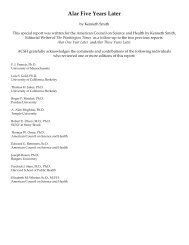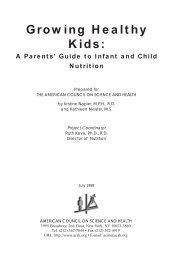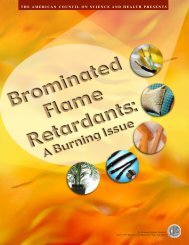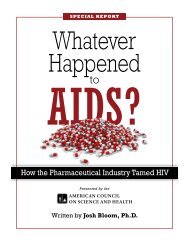The Role of Beef in the American Diet - International Meat Secretariat
The Role of Beef in the American Diet - International Meat Secretariat
The Role of Beef in the American Diet - International Meat Secretariat
Create successful ePaper yourself
Turn your PDF publications into a flip-book with our unique Google optimized e-Paper software.
<strong>The</strong> <strong>Role</strong> <strong>of</strong> <strong>Beef</strong> <strong>in</strong> <strong>the</strong> <strong>American</strong> <strong>Diet</strong><br />
are produced <strong>in</strong> greatest quantities when foods are cooked at very high<br />
temperatures, particularly if <strong>the</strong>y are cooked for long periods <strong>of</strong> time.<br />
<strong>The</strong> type <strong>of</strong> cook<strong>in</strong>g is important; more heterocyclic am<strong>in</strong>es are produced<br />
dur<strong>in</strong>g pan-fry<strong>in</strong>g, broil<strong>in</strong>g, or grill<strong>in</strong>g than dur<strong>in</strong>g stew<strong>in</strong>g, boil<strong>in</strong>g,<br />
or poach<strong>in</strong>g (39). Roast<strong>in</strong>g generates heterocyclic am<strong>in</strong>es, but practically<br />
all <strong>of</strong> <strong>the</strong>m end up <strong>in</strong> <strong>the</strong> dripp<strong>in</strong>gs ra<strong>the</strong>r than <strong>the</strong> meat (40).<br />
Although fast food meats, <strong>in</strong>clud<strong>in</strong>g hamburgers and chicken, are usually<br />
grilled or fried, <strong>the</strong> levels <strong>of</strong> heterocyclic am<strong>in</strong>es <strong>in</strong> <strong>the</strong>se products are<br />
very low or not even detectable (41), presumably because <strong>of</strong> <strong>the</strong> short<br />
cook<strong>in</strong>g times and moderate temperatures used.<br />
Even though heterocyclic am<strong>in</strong>es have been shown to be carc<strong>in</strong>ogenic<br />
<strong>in</strong> animal experiments, <strong>the</strong>ir presence <strong>in</strong> food is not a cause for<br />
alarm. Foods conta<strong>in</strong> trace amounts <strong>of</strong> numerous substances that can be<br />
shown to be carc<strong>in</strong>ogenic when concentrated and fed to laboratory animals<br />
<strong>in</strong> very high doses. Most <strong>of</strong> <strong>the</strong>se substances are naturally occurr<strong>in</strong>g<br />
food components, o<strong>the</strong>rs are syn<strong>the</strong>tic, and still o<strong>the</strong>rs are produced<br />
by cook<strong>in</strong>g. Many common foods conta<strong>in</strong> <strong>the</strong>se substances. For example,<br />
consider a lunch consist<strong>in</strong>g <strong>of</strong> a hamburger on a bun, carrot sticks,<br />
an apple, and a cup <strong>of</strong> c<strong>of</strong>fee. Or perhaps you would prefer a turkey<br />
sandwich, a lettuce and tomato salad, grapes, and tea. In ei<strong>the</strong>r case,<br />
every item <strong>in</strong> your meal would conta<strong>in</strong> animal carc<strong>in</strong>ogens. * And some<br />
<strong>of</strong> <strong>the</strong>se foods, along with many o<strong>the</strong>r foods, also conta<strong>in</strong> anticarc<strong>in</strong>ogenic<br />
substances.<br />
O b v i o u s l y, it would be unrealistic to attempt to remove all traces <strong>of</strong><br />
carc<strong>in</strong>ogens from <strong>the</strong> food supply. Current scientific knowledge <strong>in</strong>dicates<br />
that <strong>the</strong>se substances pose little or no risk when consumed <strong>in</strong> <strong>the</strong><br />
trace amounts found <strong>in</strong> food. <strong>The</strong> k<strong>in</strong>d <strong>of</strong> “zero tolerance” philosophy<br />
t h a t ’s appropriate for proven human cancer-caus<strong>in</strong>g agents with no<br />
health benefits, such as cigarettes, is <strong>in</strong>appropriate for foods that happen<br />
to conta<strong>in</strong> t<strong>in</strong>y amounts <strong>of</strong> naturally occurr<strong>in</strong>g or syn<strong>the</strong>tic carc<strong>in</strong>og<br />
e n s .<br />
Heterocyclic am<strong>in</strong>es differ from o<strong>the</strong>r animal carc<strong>in</strong>ogens found <strong>in</strong><br />
small amounts <strong>in</strong> food <strong>in</strong> only one respect: because <strong>the</strong>se substances are<br />
a product <strong>of</strong> cook<strong>in</strong>g, exposure can be decreased by choos<strong>in</strong>g cook<strong>in</strong>g<br />
methods carefully. Table 5 gives some cook<strong>in</strong>g suggestions based on<br />
publications <strong>of</strong> <strong>the</strong> National Cancer Institute and <strong>the</strong> beef <strong>in</strong>dustry. If<br />
you choose to implement <strong>the</strong>se suggestions, please remember that <strong>the</strong><br />
most important consideration when cook<strong>in</strong>g meat, poultry, or seafood is<br />
* For additional examples <strong>of</strong> foods that conta<strong>in</strong> carc<strong>in</strong>ogens and a more complete explanation<br />
<strong>of</strong> <strong>the</strong> science perta<strong>in</strong><strong>in</strong>g to this topic, see A C S H ’s Holiday D<strong>in</strong>ner Menu, available<br />
onl<strong>in</strong>e at http://www. a c s h . o rg/publications/booklets/menu99.html<br />
19










